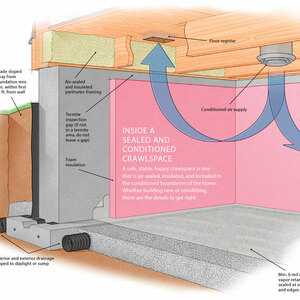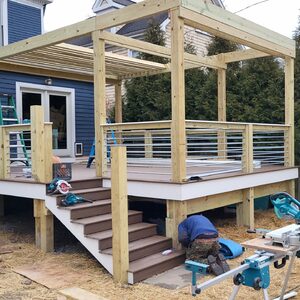I had a bad experience today with Plaster Weld by Larsen during an ongoing kitchen remodel. In theory, a bonding agent is recommended when repairing and then skim coating an older plaster wall prior to repainting. Based on a number of internet articles, I chose Plaster Weld as the bonding agent. It bonded to the cleaned and repaired wall just fine, but after 24 hours when I applied the skim coat (in this case, drying topping compound), the Plaster Weld re-wet completely, losing all film integrity. The instructions state that you can apply wet plaster to the Plaster Weld in just one hour after application of the Plaster Weld, so 24 hours seemed adequate. The skim coat and the surface of the plaster weld flowed together, turned pink (the color of Plaster Weld) and proceeded to slump on the wall as if the skim coat had been applied to a greased surface. I spent the rest of the day cleaning both topping compound and Plaster weld off the wall – not a happy way to spend my time. I will now skim coat the old fashioned way – directly onto the cleaned and sanded original surface. There is a lot of refurbishing of plaster in older homes here in Louisville, so I was initially surprised when no local supplier carried Plaster Weld. Now I know why. By the way, the Plaster Weld held just fine to the old paint – While I could remove a portion of it by washing with strong cleaner and water, I had to remove all the old paint in order to get all the Plaster Weld completely off the wall.
Discussion Forum
Discussion Forum
Up Next
Video Shorts
Featured Story

By considering things like energy-efficient mechanicals, window orientation, and renewable energy sources, homes can be evaluated to meet the energy codes. Here's what the IRC has to say.
Featured Video
How to Install Cable Rail Around Wood-Post CornersHighlights
"I have learned so much thanks to the searchable articles on the FHB website. I can confidently say that I expect to be a life-long subscriber." - M.K.

















Replies
Was the area you are repairing opened up to the lathe or just a crack, chip, or hole? How big is the area you are working on? You said you were applying a skim coat of drying topping compound, is that on top of the lathe, painted plaster, or other? Got pics of before and after?
It's a wall 8'h x 10'l. It
It's a wall 8'h x 10'l. It had a 24"x24" hole to the studs at one end where a soffit was removed, and a 16" x 8' hole to the studs by a door opening where new kitchen and garage lighting wiring was run from the basement to the attic. I patched the two holes with 5/8" drywall and built up the surface to match the existing 1" plaster surface with 90 minute setting compound.
The remainder of the plaster surface had perhaps 4 coats of glossy oil paint applied over the past 50 years. The wall has seen lots of usage over the years and the surface is scratched, has numerous nail holes (chipped out) where pictures, etc had been mounted, and the paint has been chipped to the plaster in about a zillion places and then simply painted over by the next coat.
In other words, the wall is solid, but looked pretty rough, my repair being the best looking part of the wall.
Since the painted surface was so rough, I wanted to put a good 1/16" to 1/8" skim coat over it to have a consistent surface for the new paint and make the wall "like new" once more. I did NOT want my heavier than usual skim coat to delaminate later, thus my research and the Plaster Weld. My rather thick "skim coat" was apparently too much weight for the re-wetted (by the drying type topping compound) surface of the Plaster Weld which sagged under the weight and the new topping coat slid down the wall here and there, approximately 1/8", leaving a rumpled landscape behind. Not good.
I just skim coated a 1830's
I just skim coated a 1830's kitchen plaster job with the crack-stop mesh written up in the last FHB. I had a lot of failing paint and some serious cracks, as well as a few holes. The crack-stop mesh worked exactly as advertized. It is a fair bit of work but I am very happy with the outcome.
Bill
Was the coat of compound over the areas where the plaster weld was applied too thick causing it to sag? Is the 5/8" Sheetrock that you used for a patch butted close to the original plaster or is there a gap large enough causing the to compound sag. Did you use tape (mesh)?
Bill has the right idea. I recently refinished a country kitchen in a 1930's house and used that same technique. That may be a route you should look into. Im thinking the glossy finish on the plaster may give you some headache also if you dont sand it or address it all.
Keep the details coming. We will try to figure it out. Do you have pics?
http://hudsoninterior.net/Photo_Gallery.html
To top set of photos is a plaster patch approx 5' tall. I used plaster weld on this before applying anything.
Good luck
I've been using the stuff for
I've been using the stuff for years when repairing plaster walls, though not the skim coating that you tried. I always used it between the original surface and plaster (even mixing the plaster with 1:4 plasterweld to water for a better bond), not the drying type compound you mentioned I have skim coated over the patches with regular drying type premixed joint compound, but that would have been only small areas not a whole wall. My guess so far is that the drying type compound is the problem, but I am not convinced. I will ask my brother who does this work every day and see if he has any other ideas.
I checked the Larsen website http://www.larsenproducts.com/faq.htm and their frequently asked questions indicate that the plasterweld is supposed to be "reactivated by the moisture and chemical reaction that occurs as the new plaster dries. Full bonding strength is achieved after the new plaster has completely dried." They only talk about topcoating with plaster, but they have a contact us page http://www.larsenproducts.com/contactus.html which you could try to send them a message and see if they have any ideas.
I am about to attempt the same thing
Hi Mike. I was all set on using Plasterweld to accomplish the exact same thing as you have described in my bathroom remodel. Did you ever determine what went wrong, or do you have any recommendations for doing it differently?
Thanks for the post!
Will
Results?
Hi Will,
I'm curious how your project turned out. Did you use Plasterweld? I was thinking about using it in my bathroom as well until someone sent me this thread. Some have suggested oil-based Killz primer to me rather than Plasterweld to help bond a general purpose JC skimcoat to my wall of various paint layers, JC, and exposed paper..
Thanks for your time,
Ryan
Got a horrible bathroom with peeling paint, no problem. Scrap the big pieces off, put Plaster-Weld in the big holes with a paint brush. Now put your plaster mixed with sheet rock compound into big holes and cracks. Rough up the old paint and roll Plaster-Weld over the whole bathroom. The next day paint everything with latex paint right over the Plaster-Weld, the latex paint will stick to it just fine. You can turn an old mess of a wall into a solid steam proof paint job with Plaster-Weld!